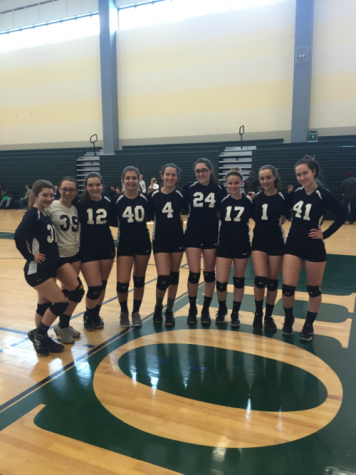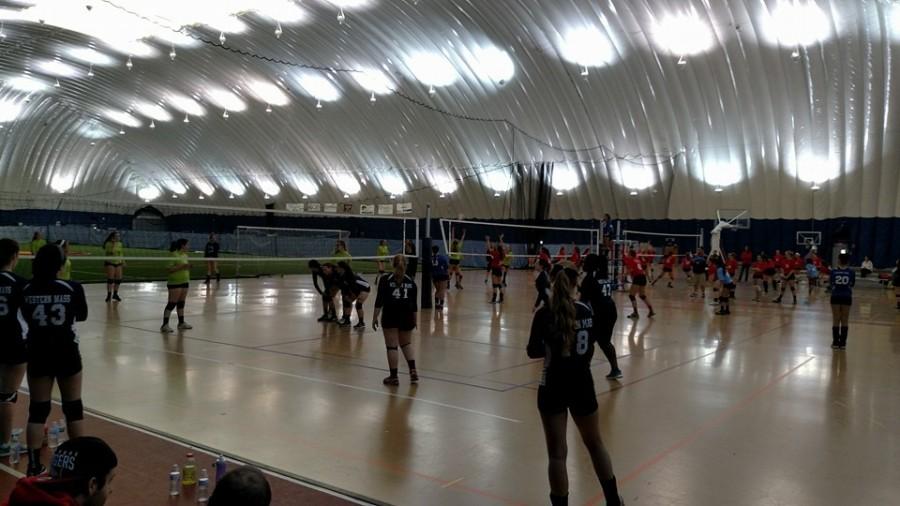Western MA Volleyball Sets Up Players for Success
March 1, 2016
You decide to go to the first girl’s volleyball game of the school season with your friends. You are expecting both teams to play awkwardly and make a lot of mistakes from not playing during the off season, but are pleasantly surprised to see a great game, full of intense, nail-biting plays. Both teams are working as smooth as if all the players are sharing one brain.
How do these volleyball players keep their skills polished when the school season is over? How do they train during the off season?
As it turns out many volleyball players, boys and girls alike, play in a winter team organized by Western MA Volleyball Club.
Every Sunday, about 40-50 individual volleyball players from around the state go to Holyoke Community College (or Stoneleigh Burnham School, depending on how far players live) at each of the designated times to practice with other players under the skillful eyes of coaches from around the state.
In fact, there are three levels to choose from in this organization: club, regional, and elite teams.
Club teams are typically younger players that are not yet in high school and only practice to work on the fundamentals. This is the cheapest option, costing $250 for the whole season, but this season ends in February while the other two teams end in May and they do not play in any tournaments.
Regional teams are most commonly chosen by high school volleyball players since they participate in day-long tournaments that extend into early May without trying out for a team or paying too much more than Club teams, costing $550 for all practices and tournaments.
As regional player, Sarah Stephenson of Ludlow High School, 16, says, “I think that Western Mass helps players train on the off season, making them better for the high school season.”
Elite teams are for varsity/college players to hone their skills, and players need to try out to make a team.
This is the most expensive option, with players shelling out $900 for the season, but players compete in more frequent, weekend-long tournaments and focus less on the basics and more on the strategy of the game.
The teams are loosely organized by skill level in order to ensure that players are coached based on their current knowledge of the game. It does not benefit the coaches nor the players to teach the basic rules to an experienced player.
While the coaching may be focused on basics for some skill levels, the drills are similar across all the teams, since the key to winning is to master the foundations of volleyball.
One of the most common drills is the Butterfly Drill.In this exercise, players are separated into four sections of the court, two on each side of the net. There are also two lone players in the middle of the court, near the net. One team on one side of the net is the throwing team, while the other is the receiver, or the passer. Opposite the throwers, on the other side of the net, are also passers.
To start, a thrower tosses a volleyball over the net, and then “follows their ball,” meaning that they run to the other side of the net and get in the back of the line that they just threw their ball to. The passer’s job is to determine where the volleyball will land, squat beneath it, and lift the ball up into the air, aiming for the lone player next to the net, by hitting the ball in an upwards motion with their forearms in a “V” shape. The passer becomes the next target by the net and the target, who catches the pass, becomes a thrower.
The purpose of this “clockwork” drill is to work on control and accuracy of passing to a target as well as fluidity in mechanics.
Players make the most of these drills, and most are actually designed to be purposefully fun and beneficial at the same time.
According to Co-Captain Brooke Sullivan, 17, who used to attend Ludlow Public Schools but who is now homeschooled, “My favorite drill is the Chair Drill, where we have to serve the volleyball over the net to a player sitting in a chair on the other side. Once the player catches someone’s serve, the server switches with them and moves it to the next of six locations on the court. Usually I’m racing against the other half of my team, which makes it really fun, but it also really helps focus the aim of my serves.”
One of the best parts of the Western MA program is the vast number of coaches observing and offering help to players. These coaches have trained with the best of the best, and a lucky few even met USA Women’s National Team Head Coach Karch Kiraly.
By having so many coaches available to help players improve their skills and fix mistakes during gameplay, practices are more one-on-one, which allows players to develop their abilities more successfully.
According to Assistant Coach Michaela LaBlanc, 18, “Each coach has a vast knowledge of the game and do so much to better themselves…They teach us better because there is an individualized way they teach us” [referring to the organization levels of the teams].
In addition to the number of coaches there are available, there are also many different players at each practice. By having a great variety of players with strengths in different areas, players are able to learn and grow from each other.
For example, a shorter player struggling with hitting the ball over the net can more successfully use the tips from a similarly short player who can hit very well.
Relationships with other players are very important, on and off the court. Close friendships lead to excellent communication during a game, which permits players to work smoothly and avoid allowing the ball to drop to the floor.
Also, during practices, positive criticism and encouragement can notably increase the self-confidence and determination a player needs to continue to challenge themselves and enhance their skills.
Western MA Volleyball not only creates an environment where various players can work together to improve their knowledge of volleyball, but it also organizes players into teams.
These teams further promote self-confidence and communication as they practice every week and play together in tournaments.
Plus, it’s fun!
In their teams, players develop cheers to boost each other’s energy, especially when they losing to the opposing team.
“My team this year for Western Mass has opened my eyes to how a team really should be and the connection between us all makes us accomplish so much more. Being on the team with some of my close friends and new friends has made me a better team player with new opportunities,” comments Western MA player Marisa Lombardi, 16, of Ludlow High School.
Each team also entitle a certain player (or players) to be the captain(s) of the team. This teaches players leadership and responsibility since they are the only ones, besides the coach, who can challenge a referee’s bad call during a tournament.
Practice is very important, indeed, but tournaments bring the skills and strategies learned in practice to life and cause players to make quick decisions in real-time games.
It is because of these tournaments, coaches, and peers that volleyball players can not only avoid the rustiness at the beginning of the school season from not playing during the off season , but can “set” themselves up for an even more successful season.
As Coach Rebecca Godbout, 19, summarizes, “[Western MA Volleyball] helps young athletes develop basic fundamental skills and to improve technique. It prepares athletes to play more competitively during the high school season.




Noemi • Jan 9, 2018 at 8:18 am
I was just wondering if you have an off season volley ball lessons for my 14 year old daughter. She has 4 years of experience and played on the varsity team at her highschool as a freshman. Thanks you
Ingrid